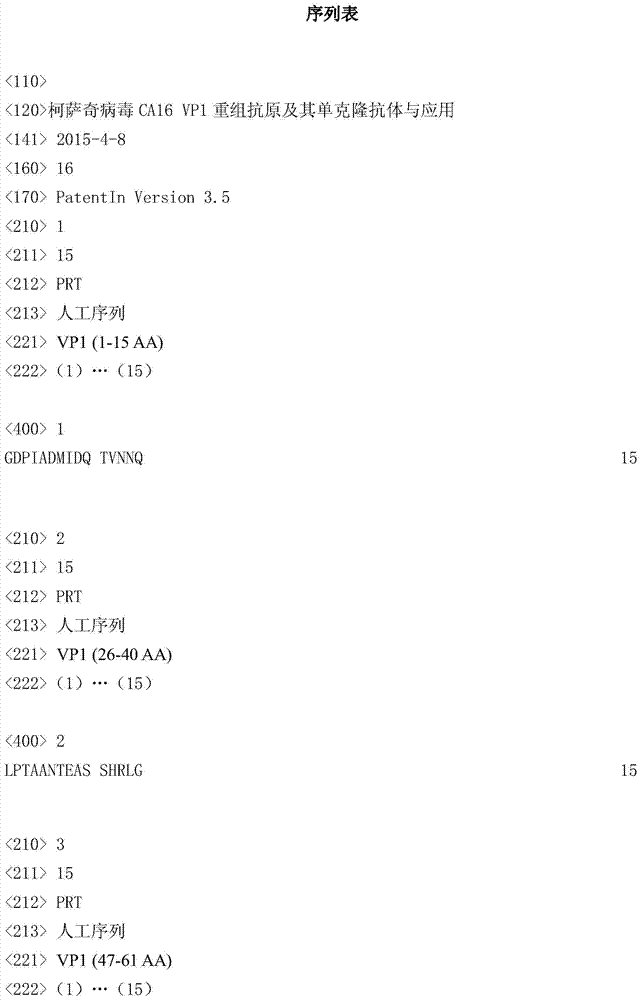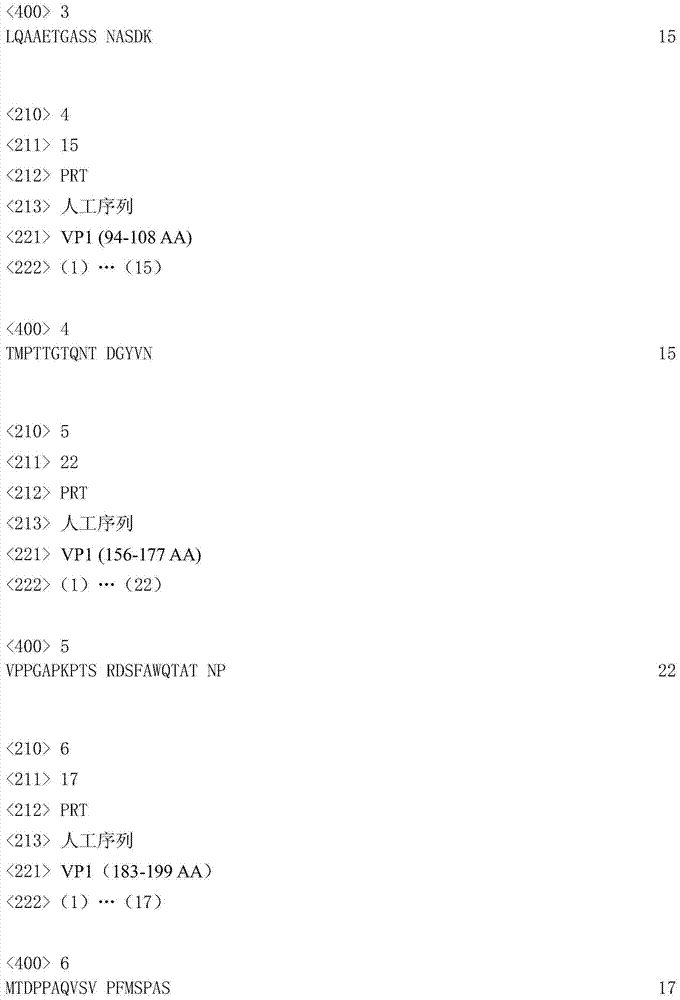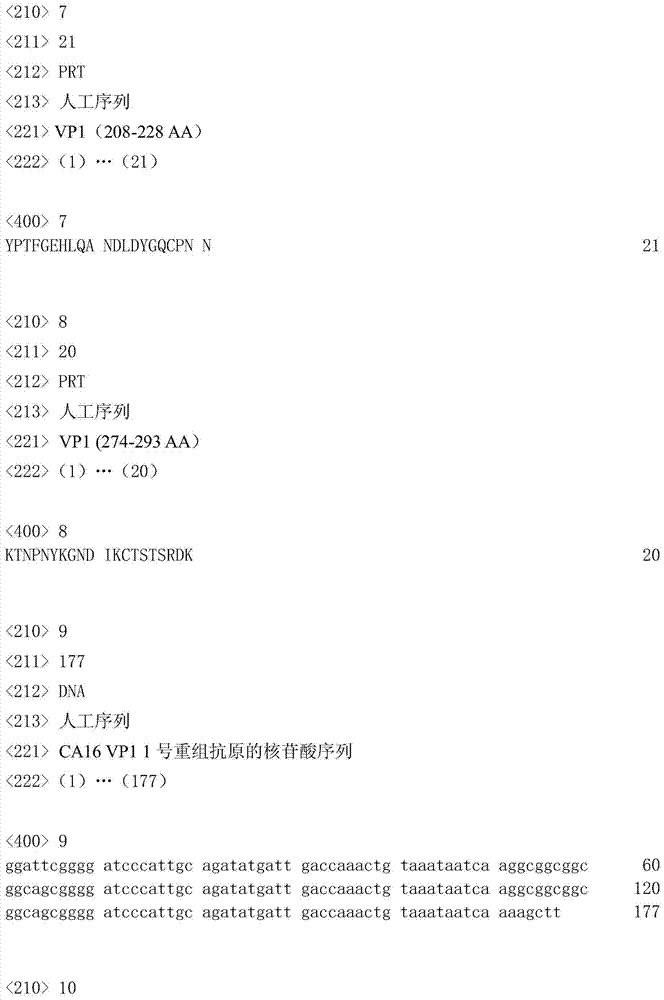Coxsackie virus CA16 VP1 recombinant antigens, and monoclonal antibodies and application thereof
A technology of CA16VP18 and Coxsackie virus, applied in the field of molecular biology, can solve the problem of outbreaks in children and achieve the effect of early screening
- Summary
- Abstract
- Description
- Claims
- Application Information
AI Technical Summary
Problems solved by technology
Method used
Image
Examples
Embodiment 1
[0027] Example 1: Selection of Candidate Antigen Epitopes
[0028] By searching NCBI (National Center for Biotechnology Information, http: / / www.ncbi.nlm.nih.gov / ), a total of 51 CA16 sequences of CA16 were analyzed, and according to the homology of amino acid sequences, they were sorted and screened sequentially. 8 linear epitope antigen sequences conserved in each genotype sequence. Their amino acid sequences are shown in Table 1, respectively.
[0029] Table 1 CA16VP1 linear epitope sequence of the present invention
[0030] serial number amino acid site amino acid sequence 1 1-15AA GDPIADMIDQTVNNQ 2 26-40AA LPTAANTEASSHRLG 3 47-61AA LQAAETGASSNASDK 4 94-108AA TMPTTGTQNTDGYVN 5 156-177AA VPPGAPKPTSRDSFAWQTATNP 6 183-199AA MTDPPAQVSVPFMSPAS 7 208-228AA YPTFGEHLQANDLDYGQCPNN 8 274-293AA KTNPNYKGNDIKCTSTSRDK
Embodiment 2
[0031] Example 2: Cloning and expression of CA16 VP1 recombinant antigen
[0032] 1. Construction of CA16 VP1 recombinant anti-expression plasmid
[0033] 1.1 Synthesis of CA16 VP1 recombinant antigen
[0034] According to the amino acid sequences of the above eight CA16 VP1 antigens, and using gene recombination methods, the above CA16 VP1 sequences were respectively added to a flexible short peptide (GGGGS or GGGGSGGGGSGGGGS or AAY) and linked together (the eight amino acid sequences were respectively combined with the flexible short peptide amino acid When connecting the sequences, each amino acid sequence was repeated 3 times), the amino acid sequence was translated into a nucleotide sequence using Escherichia coli preferred codons, and EcoRI and HindIII restriction sites were introduced at the 5' end and 3' end respectively (see the sequence listing), and commissioned Shanghai Jierui Bioengineering Co., Ltd. to synthesize the gene of the above-mentioned CA16VP1 antigen s...
Embodiment 3
[0052] Example 3: Preparation of monoclonal antibody by immunizing mice with recombinant CA16 VP1 antigen protein
[0053] 1. Preparation of immunization antigens: The preparation method of 8 kinds of CA16 VP1 recombinant antigens was carried out according to the method in Example 2.
[0054] 2. Mice immunization: BALB / c mice were immunized with recombinant CA16 VP1 protein. Immunization procedure: For the first immunization, take recombinant CA16VP1 protein mixed with Freund's complete adjuvant to emulsify, immunize BALB / c mice, 50ug / mouse, intraperitoneal injection; carry out the second immunization after an interval of 14 days: take recombinant VP1 protein and Freund's incomplete adjuvant The adjuvant was mixed and emulsified, and BALB / c mice were immunized with 50ug / mouse, and injected intraperitoneally; blood was collected 7 days later, and the CA16 antibody activity was measured by indirect ELISA. No adjuvant was added to the mouse with the highest antibody titer, and t...
PUM
 Login to View More
Login to View More Abstract
Description
Claims
Application Information
 Login to View More
Login to View More - R&D
- Intellectual Property
- Life Sciences
- Materials
- Tech Scout
- Unparalleled Data Quality
- Higher Quality Content
- 60% Fewer Hallucinations
Browse by: Latest US Patents, China's latest patents, Technical Efficacy Thesaurus, Application Domain, Technology Topic, Popular Technical Reports.
© 2025 PatSnap. All rights reserved.Legal|Privacy policy|Modern Slavery Act Transparency Statement|Sitemap|About US| Contact US: help@patsnap.com



